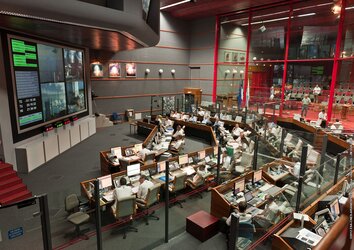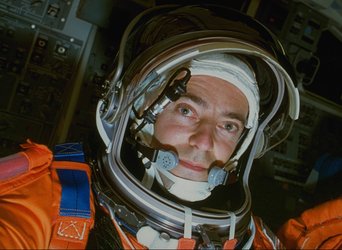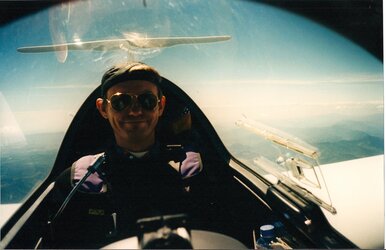Portraits of Ariane 5: No.6, Julio Monreal
The Ariane 5 launcher said a graceful goodbye in July 2023 after nearly three decades of loyal service. Many people contributed to its success over the years and, in this series of conversations, some have shared their personal and professional experiences with Annia Domènech.
For the sixth in the series, we talked with Julio Monreal, former Ariane 5 Operational Launch System Manager.
"Even as a youngster, I was enthusiastic about space and rockets – I managed to get hold of some documentation from NASA, and from the Soviet space programme, and used it to build a two-metre-tall scale model of Saturn V.
“I joined ESA’s Directorate of Space Transportation Systems in March 1989, just when Ariane 4 was entering its operational phase. My role was to provide support to the ESA spacecraft projects launched by Ariane 4, checking their interfaces with the launch system. I was only 33, while most of the team were senior engineers. I remember a colleague teasing me, ‘You’re so young – what are you doing here?’

“Some months later, I went to Kourou for a meeting to prepare for the launch on Ariane 4 of the first European remote-sensing satellite, ERS. When I met the ERS manager, he asked me a familiar question, ‘What are you doing here?’
“During my first mission to French Guiana, staying at a ship-hotel on the Kourou river, I was surrounded by the sounds and spicy smells of the jungle. While taking in the space facilities all around me, I repeated to myself, ‘This is it. I’m actually here working at the Spaceport!’
“In parallel, Ariane 5 was under development and we were looking for the first spacecraft to fly on the first Ariane 5 launches. My work consisted in defining how the spacecraft would be accommodated on the launcher, fitted within the fairing, and attached and connected to the launcher through its payload adaptor, as well as verifying that the spacecraft had been appropriately tested for its ability to withstand the challenging launch environment in terms of acceleration, vibration, noise, and so on.
“In 1993, I moved to Kourou, seconded as CNES staff to the Operations Division of the Guiana Space Centre (CSG), Europe’s Spaceport, where I worked for five years as Directeur des Opérations – ‘DDO’ or Launch Range Operations Manager in English. I was responsible for coordination between the launch range facilities, the launcher and the spacecraft during the launch campaign, right up to launch. My role was to ensure that the work was progressing in accordance with the operations plan.
“During the countdown, on the day of a launch, the team prepares the launcher for liftoff while the launch range checks that all ground stations are operational and that the weather conditions are suitable for launch. Whenever a problem arose, I was responsible for rearranging the schedule so that the problem could be solved while other operations were carried out, and I was always present for the final synchronised sequence in the last minutes before liftoff.
“It was rewarding work, providing me with an end-to-end view of the launch range, the launcher and the spacecraft. On launch day, at the end of the countdown, I was the one who received the green light from the telemetry, from the radars, from the telecoms and finally from the launcher… all systems go!
“During my stay at the CSG, I served as DDO for five Ariane 4 launches and one Ariane 5 launch: the second Ariane 5 qualification launch (Ariane 502). I was in the control centre when the first Ariane 5 launch (501), failed on 4 June 1996. Seeing the very first Ariane 5 launcher explode just seconds after liftoff was a very difficult experience for all of us.

“The second Ariane 5 launch campaign was a tough one as the stakes were high following the first launch failure. On the morning of 30 October 1997, the launch countdown was proceeding nominally as I announced the beginning of the synchronised sequence at T minus seven minutes. Tensions began to rise when, at T minus 48 seconds before liftoff, the countdown stopped due to a red status.
“Once the problem had been resolved, the countdown resumed. The final sequence proceeded smoothly and I announced, ‘Décollage, liftoff’, but the atmosphere of suspense continued when a high roll – a rotation of the launcher on its vertical axis – occurred during the main stage propulsion phase. The launcher control system was able to compensate for the high roll but only after the main stage separation, but the orbit reached by the launcher was lower than planned.
“The problem was corrected after the flight. The third qualification flight, Ariane 503, performed a perfect dual mission, releasing the Atmospheric Reentry Demonstrator capsule on a suborbital trajectory and injecting a mock-up telecommunications satellite into geostationary orbit, demonstrating that Ariane 5 was ready to begin its remarkable operational life.
“Ariane 5 arrived at a time when fierce competition and private launch companies did not yet exist. Continuing the success of Ariane 4, it held the leading position in the commercial market and was a hugely important project both for Europe and for the European space industry.
“In 1998, I returned from French Guiana to work in the Automated Transfer Vehicle (ATV) team at ESTEC, in the Netherlands, which was a professional privilege. I worked on the ATV propulsion system and on the ATV interfaces with Ariane 5 on what was a new mission for the launcher, bringing to low-Earth orbit a huge 20-tonne spacecraft designed to supply the International Space Station.
“I participated in the studies on the launcher configuration, which set out to respond to a number of questions. Which Ariane 5 configuration would be optimal for the mission? Could the ATV be launched only with the lower part of the launcher, or would the full Ariane 5 structure be required?
“A technical analysis of performance indicated that removing the upper stage of the launcher would theoretically be the better solution. Though this was indeed true, other aspects, such as flight control, also required careful consideration. How could flight control be managed in the few seconds following separation from the lower part of Ariane 5? The risk was that if the ATV did not take over control quickly, it would simply crash back to Earth because of its suborbital trajectory.
“We eventually concluded that attempting to reach a stable orbit without the complete Ariane 5 structure would be difficult and extremely risky. The upper stage, the EPS, remained in the Ariane 5 version used for ATV, and its reignition capability was developed and qualified. This paved the way toward other future launch missions such as the Galileo navigation constellation, for which 12 spacecraft were launched by three Ariane 5 launchers of a similar version some years later.
“I vividly remember the ATV structural model tests on the HYDRA test stand at ESTEC. After a full week of tests, just as we were ready to increase the vibration levels on the stand, we heard a loud crack; I was terrified that we had broken something. Fortunately, we were able to verify that the ATV model was intact.
“I also remember a visit to the CSG with our ISS partners: Americans from NASA and Russians from Energia. Among the Russians were a senior engineer – the father of the Russian docking system – and a young engineer. To my surprise, they called late one night because their car had got a flat tyre and they didn’t have a clue how to change the wheel! I thought to myself, ‘What! How is that possible? They’re Russian engineers!’
“I dutifully set off to show them how to change the wheel. The senior engineer presented me with a signed copy of his book, in Russian, about the docking system, which still holds pride of place in my library.

“In 2003, I moved back to Paris to work in the Directorate of Launchers and, in 2006, took over responsibility for the Ariane 5 Research and Technology Accompaniment programme (ARTA) as manager of the Operational Launch System, an ESA/CNES/DLR integrated team.
“Our job was to maintain qualification of the launcher during the entire lifetime of Ariane 5. Though there were some difficult moments, every time Ariane 5 lifted off, it took my breath away. We launched all sorts of missions on Ariane 5, from communications missions, to Earth observation missions, such as Envisat and Meteosat, as well as five ATVs to the Space Station.
“We also launched missions of high scientific value, including the amazing Rosetta mission, with its Philae comet lander, the NASA/ESA/CSA James Webb Space Telescope and, more recently, the Juice mission to Jupiter.
“Throughout my time at ESA and at CNES, I witnessed more than 150 Ariane launches, always from the inside of a control room. The one exception was the Hispasat-1A launch on 10 September 1992 by Ariane 4. Hearing the noise and feeling the pressure waves from the rocket engines was an experience that will stay with me forever.
“From 2016 to 2020, in my last four years as staff at ESA, I worked for Ariane 6 as Deputy Manager of the Launch System Architect Team. Having worked on Ariane 4, Ariane 5 and Ariane 6, I am proud to have contributed to the implementation of the European space transportation systems enabling space utilisation and exploration, and continue to provide support today, as a consultant, to the Ariane 6 Launch System Architect.
“My dream is to see Ariane 6 contributing to the settlement of the Moon and ESA leading international initiatives with European space transportation systems to continue the exploration of the Solar System and beyond. Thank you Ariane 5, and go Ariane 6!”
Ariane 5 had 117 successful launches and placed 239 satellites in orbit. The heavy launcher carried prominent payloads, such as ESA’s comet-chasing Rosetta mission, a dozen Galileo navigation satellites, the James Webb Space Telescope and recently Juice, the explorer of Jupiter and its icy moons.








